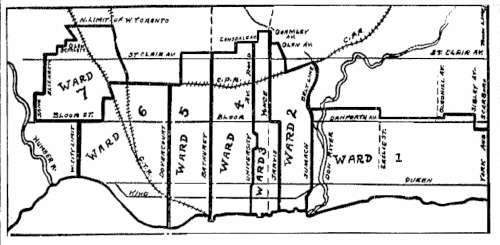1910 Toronto municipal election
Municipal elections were held in Toronto, Ontario, Canada, on 1 January 1910. George Reginald Geary was elected to his first term as mayor.[1] Two plebiscites were passed:

Three by-laws were also voted on, two passed. The approved by-laws were:
- Building new buildings on the Canadian Exhibition Grounds;
- Building more fire and police stations.[1]
The by-law that failed to win approval was the one calling for the extension of Bloor Street by means of a viaduct.[1]
Voting eligibility
Unlike the present era, the right to vote was not universal to all citizens. Notably, since 1884, most women were still not allowed to vote as they had to be either a widow or single, and own land.[2] There were also restrictions on which men could vote on what options. A complicated system based on what land was owned or leased decided if a person could vote on the money by-laws or not. The following excerpt from The Globe explains the process:
- Every elector entitled to vote for Mayor has one vote on the subway or tube question. Every elector entitled to vote for the Board of Education has a vote on the question of returning to the ward system of electing trustees, or retaining the present system of electing trustees by general vote. The only persons entitled to vote on the three money by-laws are freeholders marked on the voters' list "M, F. & F." or "F." In previous years all persons marked on the voters' list "Lessee" had the right to vote on debenture by-laws, but the law has been changed in this regard. There are exceptions, however, where a person has a long lease which entitles him to vote. In such cases there will be an entry in the voters' list, "Entitled to vote on debenture by-laws."[3]
Toronto mayor
Mayor Joseph Oliver did not run for re-election. George Reginald Geary had run for the mayor's office in 1908 but lost to Oliver before winning a seat on the Board of Control the next year. In an open race in 1910, Geary's main opponent was fellow Controller Horatio Clarence Hocken, founder of the Toronto Star and social reformer whom he defeated by 4,000 votes.
- Results[1]
- George Reginald Geary - 18,996
- Horatio Clarence Hocken - 14,999
- Thomas Davies - 644
- Robert Buist Noble - 192
- Joel Marvin Briggs - 93
Board of Control
All results are sourced from the 3 January 1910 The Globe, page one.
Two spots opened up on the Toronto Board of Control as a result of Controllers Geary and Hocken both running for mayor. Tommy Church and Thomas Foster joined the Board for the first time and Frank S. Spence returned, this time topping the vote, after being defeated the previous year. William Spence Harrison was defeated meaning only one incumbent, Labourite J.J. Ward, was re-elected.
- Frank S. Spence - 13,879
- J.J. Ward (incumbent) - 13,401
- Tommy Church - 12,657
- Thomas Foster - 10,841
- William Spence Harrison (incumbent) - 9,946
- William Peyton Hubbard - 9,498
- Mark Bredin - 8,708
- James Henry McGhie - 7,511
- James Hales - 5,852
- Albert Chamberlain - 2,730
City council

- Ward 1
- Thomas N. Phelan - 3,194
- Daniel Chisholm (incumbent) - 2,887
- Zephaniah Hilton (incumbent) - 2,402
- William J. Saunderson - 1,957
- Andrew McMillan (incumbent) - 1,550
- James William Jackson - 1,449
- Ward 2
- John O'Neill (incumbent) - 2,544
- Henry Adams Rowland - 1,877
- William J. Hambly - 1,647
- Robert Yeomans - 1,234
- Donald Urquhart - 900
- James Edward Forfar - 573
- Frederick Hogg - 460
- James O'Hara - 269
- Frederick Burrows - 186
- Ward 3
- Charles A. Maguire (incumbent) - 3,623
- Sam McBride - 2,759
- Norman Heyd - 2,619
- Stewart Nassau Hughes - 1658
- John Kirk - 1,291
- Ward 4
- George Weston - 2,895
- Albert Welch (incumbent) - 2,226
- George McMurrich (incumbent) - 2,228
- James Commeford - 1,776
- A.E. Hacker - 1,602
- A.R. Williamson - 1,462
- J.N Sloan - 483
- Ward 5[4]
- John Dunn (incumbent) - 2,605
- Joseph May - 2,508
- Robert Henry Graham (incumbent) - 2,023
- Robert William Dockeray - 1,792
- Albert James Keeler (incumbent) - 1,764
- Peter Whytock - 1,698
- John L. Richardson - 1,414
- Richard Pugh Powell - 730
- Ward 6[1]
- Jesse O. McCarthy - 3,276
- James Arthur McCausland - 2,992
- David Spence - 2,571
- Fred McBrien - 2,562
- John James Graham (incumbent) - 1,830
- Thomas Edward Earls - 235
- Ward 7[5]
- A.J. Anderson (incumbent) - acclaimed
- William Alexander Baird (incumbent) - acclaimed
References
- "Controller Geary elected mayor". The Globe. Toronto. January 3, 1910. p. 1.
- "William Holmes Howland (b. 1844-d.1893) Mayor of Toronto - 1886-1887". Toronto History: Mayors and Reeves. Toronto: City of Toronto. 2011. Archived from the original on January 15, 2013. Retrieved December 5, 2011.
- "In the civic arena". The Globe. Toronto. January 1, 1910. p. 12.
- "Official Figures of the Election". Toronto Daily Star. Toronto. January 3, 1910. p. 1.
- "Controller Geary elected mayor". The Globe. Toronto. January 3, 1910. p. 2.